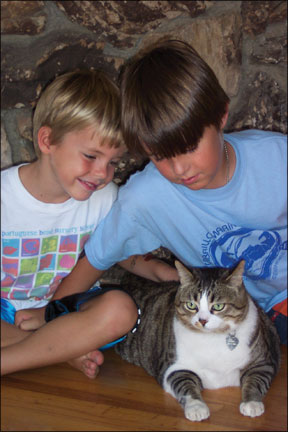Who isnt charmed by photographs of kids holding and petting cute, cuddly kittens? Children can benefit from having a cat, and vice versa. “The experience of bonding between the child and the

288
cat can be invaluable,” says Larry Lachman, PsyD, a licensed clinical psychologist, animal behavior consultant and author of Cats on the Counter: Therapy and Training for Your Cat, “and a child learns to increase compassion and empathy for nonhuman life.”
Pets teach children the responsibility of doing chores like feeding the cat, changing the water and cleaning the litter box. Having a pet can also provide a family with its own pet-assisted therapy. “Pets may help kids with social anxiety problems to cope,” says Dr. Lachman. The child has a companion, and the pet helps improve the quality of the childs life. “Pets also teach the larger lessons regarding dog and cat overpopulation and the importance of spaying and neutering,” says Dr. Lachman.
If you are thinking of adopting a cat or kitten for your child, weigh the option carefully. Although adopting a cat may be beneficial for some children, it may not be right for all. “Cats and kids can be a good match if certain preconditions are met,” says Dr. Lachman.
What’s an Appropriate Age?
The age of the child is important in determining whether adopting a cat is a good choice (see sidebar). Before bringing home a new pet, ideally a child should be six or seven years old. Younger children are still developing their reflexes and their eye-hand coordination. “Before that, children lack impulse control,” says Dr. Lachman. Without impulse control, some children may kick, push or pull on the cat, which can endanger the cat and possibly endanger the child if the cat decides he doesnt want to take it.
A cat that is constantly pounded, stepped on or spooked by a child, no matter how unintentionally, will either fight or flee, neither of which generates the desired benefits of having a pet for child or parent. “If a child hasnt yet developed empathy and doesnt realize that the cat is a living being, the child may treat it like a stuffed animal,” says Dr. Lachman. Older children are better at accepting the cat as a feeling being. “Kids between seven and 12 are in the concrete operational stage of development where they can reason logically and have greater control of their impulses,” says Dr. Lachman.
How old the cat should be depends on the cat and the child. “On the one hand, an older cat can protect itself, but it can be aggressive if it has not been socialized to children,” says Dr. Lachman. If you bring home a kitten or cat under one year of age, it can be socialized positively with the kids, but the cat will need protection from accidental harm, since it is relatively small. If the cats sense of safety is not protected, it may become aloof at best or exhibit fear aggression or dominance aggression.
If you want to adopt a cat or kitten as a companion for your child, some preparation is in order. Put the cat in a separate room, similar to the technique used when bringing a second cat into the home.
Desensitize the Cat
“Rub the child with a towel and take it into the cats room so the cat can smell it,” says Dr. Lachman. When the two meet, have the child sit on the floor to reduce its threat to the animal and place the cat near the child. “Allow the cat to investigate the child,” says Dr. Lachman. Let the child give the cat some cat treats to soothe the introductions. “Demonstrate to the child the correct way to pet a cat,” says Dr. Lachman. After five to 10 minutes, end the session. Do two sessions a day for two to four weeks. This may seem like a long time, but the relationship the child develops with the cat early on will last for many years.
During the sessions, have the child move around the cat so the cat becomes used to the childs movements. “Look for signs of aggression,” says Dr. Lachman. If the cat and child appear comfortable with each other, allow them to interact freely.
If you are adopting a cat for your child, keep the cat indoors. “Indoor cats have fewer fights and infections,” says Dr. Lachman, “and they live longer and usually enjoy healthier lives.” With careful planning and monitored introductions, your child and cat will share many years together. v



